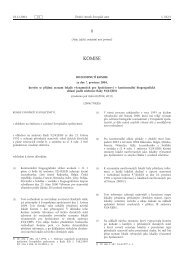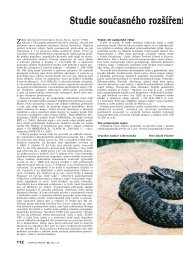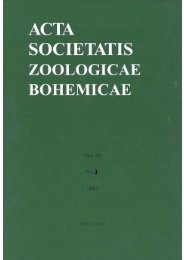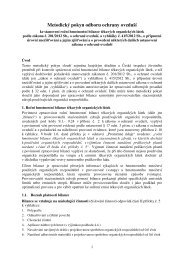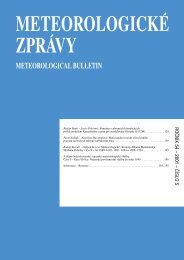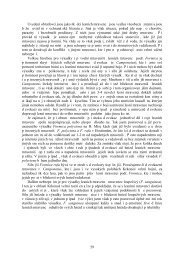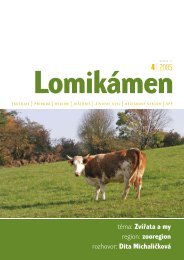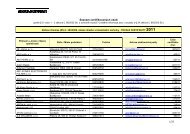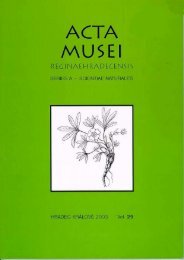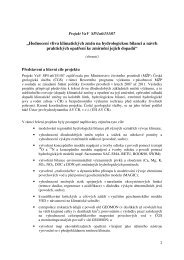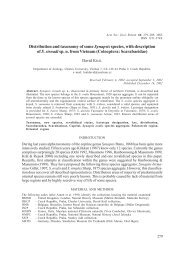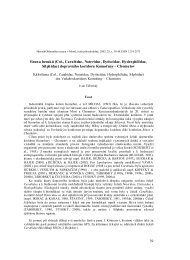journal of forest science
journal of forest science
journal of forest science
You also want an ePaper? Increase the reach of your titles
YUMPU automatically turns print PDFs into web optimized ePapers that Google loves.
JOURNAL O OREST SCIENCE, 47, 2001 (7): 285–293<br />
Simultaneous modelling <strong>of</strong> stand volume yield, dominant height<br />
and basal area growth models<br />
L.YUANCAI 1 , C. P. MARQUES 2 , J. M. BENTO 2<br />
1 Research Institute <strong>of</strong> Forest Resource Information Technique, Chinese Academy <strong>of</strong> Forestry, Beijing, China<br />
2 Department <strong>of</strong> Forestry, Universidade de Trás-os-Montes e Alto Douro, Vila Real, Portugal<br />
ABSTRACT: Forest growth and yield models are <strong>of</strong>ten composed <strong>of</strong> a system <strong>of</strong> compatible, interdependent and analytically<br />
related equations rather than <strong>of</strong> a single equation. Most <strong>forest</strong> researchers have recognized that the <strong>forest</strong> stand dynamics<br />
system should be described by a system <strong>of</strong> simultaneous and interdependent equations. The two- and three-stage<br />
least squares (2SLS and 3SLS) and seemingly unrelated regression (SUR) techniques from econometrics have been widely<br />
used to estimate the coefficients <strong>of</strong> <strong>forest</strong> growth and yield model system. This study analyzes a system <strong>of</strong> three interdependent<br />
equations for predicting the future stand volume yield, the future stand dominant height and the future stand basal<br />
area for eucalyptus plantations as an integrated system given by initial stand conditions. The coefficients <strong>of</strong> the system are<br />
estimated from Eucalyptus globulus Labill. stands in the Central inland <strong>of</strong> Portugal by using 3SLS, SUR and OLS, respectively.<br />
The three methods are evaluated and compared on some statistic indicators. The results indicate that there is a small<br />
difference between the three approaches in the particular case, but the system estimation methods perform better for<br />
a system <strong>of</strong> simultaneously interdependent equations in theory. Therefore, the appropriate system estimation approaches<br />
are recommended for estimating coefficients in simultaneously interdependent systems <strong>of</strong> <strong>forest</strong>ry equations.<br />
Keywords: comparison; growth and yield model; simultaneous equation<br />
Modelling methodology <strong>of</strong> growth models at present<br />
is becoming increasingly sophisticated as <strong>forest</strong> biometricians<br />
put forward new biological rationale, advanced<br />
statistical techniques, and powerful computing technology<br />
to solve growth and yield prediction problems.<br />
An extensive variety <strong>of</strong> growth and yield models have<br />
been developed. However, growth and yield models,<br />
which describe <strong>forest</strong> stand dynamics by using data from<br />
permanent sample plots or inventory sample plots with<br />
real growth series, are <strong>of</strong>ten composed <strong>of</strong> a system <strong>of</strong><br />
compatible, interdependent and analytically related equations<br />
(CLUTTER 1963; SULLIVAN, CLUTTER 1972; BOR-<br />
DERS, BAILEY 1986; BURKHART 1986; REED 1986;<br />
DANIELS, BURKHART 1988). Most <strong>forest</strong> researchers<br />
have recognized that there is a strong correlation and<br />
feedback mechanism between variables that are used to<br />
describe growth and yield relationships. Therefore, <strong>forest</strong><br />
stand dynamics should be described by a simultaneous<br />
and interdependent system <strong>of</strong> equations rather than<br />
by separate and isolated individual equations.<br />
Financial support for this work was partially provided by the NSFC program (30070620).<br />
In <strong>forest</strong> biometrics, there are two categories <strong>of</strong> methods<br />
for estimating simultaneous and interdependent systems<br />
<strong>of</strong> equations.<br />
One method <strong>of</strong> estimating parameters in a system <strong>of</strong><br />
equations is to fit one (or more) <strong>of</strong> the equations using<br />
Ordinary Least Squares (OLS) techniques and to solve<br />
for the coefficients in the other(s) by invoking the specified<br />
algebraic relationships between parameters (SULLI-<br />
VAN, CLUTTER 1972). This solution has obvious<br />
shortcomings. As the parameter estimates are stochastic,<br />
the final result will depend on the arbitrary choice which<br />
equation(s) is(are) fitted and which is(are) derived. Thus,<br />
BURKHART and SPRINZ (1984), REED and GREEN<br />
(1984), BYRNE and REED (1986), KNOEBEL et al. (1986)<br />
and REED (1986) simultaneously estimated the structural<br />
parameters by minimizing the squared error loss function,<br />
which brought about a substantial improvement for<br />
the total system. However, BORDERS and BAILEY (1986)<br />
and LEMAY (1990) indicated that estimates obtained by<br />
minimizing squared error loss functions may not be con-<br />
J. FOR. SCI., 47, 2001 (7): 285–293 285



